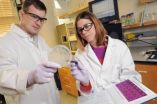(Press-News.org) UNIVERSITY PARK, Pa. -- Children who overreact to stressors may be at risk of becoming overweight or obese, according to researchers at Penn State and Johns Hopkins University.
"Our results suggest that some children who are at risk of becoming obese can be identified by their biological response to a stressor," said Lori Francis, associate professor of biobehavioral health. "Ultimately, the goal is to help children manage stress in ways that promote health and reduce the risks associated with an over- or under-reactive stress response."
Francis and her colleagues -- Douglas Granger, director of the Center for Interdisciplinary Salivary Bioscience Research at Johns Hopkins University, and Elizabeth Susman, Jean Phillips Shibley Professor of Biobehavioral Health at Penn State -- recruited 43 children ages 5- to 9-years-old and their parents to participate in the study.
To examine the children's reactions to a stressor, the team used the Trier Social Stress Test for Children, which consists of a five-minute anticipation period followed by a 10-minute stress period. During the stress period, the children were asked to deliver a speech and perform a mathematics task. The team measured the children's responses to these stressors by comparing the cortisol content of their saliva before and after the procedure.
The researchers also measured the extent to which the children ate after saying they were not hungry using a protocol known as the Free Access Procedure. The team provided the children with lunch, asked them to indicate their hunger level and then gave them free access to generous portions of 10 snack foods, along with a variety of toys and activities. The children were told they could play or eat while the researchers were out of the room.
The results appeared online in the December 2012 issue of the journal Appetite.
The team found that, on average, the children consumed 250 kilocalories of the snack foods during the Free Access Procedure, with some consuming small amounts (20 kilocalories) and others consuming large amounts (700 kilocalories).
"We found that older kids, ages 8 to 11, who exhibited greater cortisol release over the course of the procedure had significantly higher body-mass indices [BMI] and consumed significantly more calories in the absence of hunger than kids whose cortisol levels rose only slightly in response to the stressor," Francis said. "We also found that kids whose cortisol levels stayed high -- in other words, they had low recovery -- had the highest BMIs and consumed the greatest number of calories in the absence of hunger."
According to Francis, the study suggests that children who have poor responses to stressors already are or are at risk of becoming overweight or obese. In her future work, she plans to examine whether children who live in chronically stressful environments are more susceptible to eating in the absence of hunger and, thus, becoming overweight or obese.
"It is possible that such factors as living in poverty, in violent environments, or in homes where food is not always available may increase eating in the absence of hunger and, therefore, increase children's risk of becoming obese," she said.
INFORMATION:
The Children, Youth and Families Consortium at Penn State and the National Institutes of Health provided funding for this research.
** sdl **
Recent studies have identified correlations between cigarette smoke-induced microRNA (miRNA) expression and different aspects of lung cancer; however, it is unclear how miRNA expression directly contributes to carcinogenesis. MiRNAs regulate the expression of target genes and can have a significant impact on when and how well different gene products are expressed. In this issue of the Journal of Clinical Investigation, David Schrump and colleagues at the National Cancer Institute in Bethesda, MD, measured miRNA expression in normal human lung cells exposed to cigarette ...
Diabetic patients are more than twice as likely to die from a heart attack as non-diabetic patients, but the mechanisms that underlie increased heart attack-related mortality in diabetic patients are unknown. High levels of the oxidized form of the protein CamKII (ox-CaMKII) have been linked to increased risk of sudden death after heart attack. Additionally, hearts from diabetic patients have significantly greater ox-CAMKII compared to hearts from non-diabetic patients. In this issue of the Journal of Clinical Investigation, Min Luo and colleagues at the University of Iowa ...
A smoking gun in lung cancer epigenetics
Recent studies have identified correlations between cigarette smoke-induced microRNA (miRNA) expression and different aspects of lung cancer; however, it is unclear how miRNA expression directly contributes to carcinogenesis. MiRNAs regulate the expression of target genes and can have a significant impact on when and how well different gene products are expressed. In this issue of the Journal of Clinical Investigation, David Schrump and colleagues at the National Cancer Institute in Bethesda, MD, measured miRNA expression in normal ...
In the most comprehensive report in a half century, experts today described fundamental changes needed in the education of the scientists whose work impacts medicine, drug discovery and virtually every other discipline. The result of a year-long project of a presidential commission of the American Chemical Society (ACS), the world's largest scientific society, the report was the topic of a symposium here at the 2013 annual meeting of the American Association for the Advancement of Science (AAAS).
Although it concluded that the state of graduate education in the chemical ...
From sore feet to backaches, blame it on human evolution.
"Because we are the only mammals to walk on two feet," says Bruce Latimer, an anthropologist from the Case Western Reserve University School of Dental Medicine.
Latimer will present "A Backache of Longstanding: An Evolutionary Perspective on the Human Vertebral Column" at the 2013 American Association for the Advancement of Science's annual meeting in Boston, Feb. 14-18. His talk will be featured in the session, "The Scars of Human Evolution."
Latimer and other panelists will explain how adapting to upright ...
BOSTON - The notion of "personalizing" health care through the use of an individual's genetic code has attracted considerable enthusiasm and investment. Impressive examples, confirmed through formal studies of clinical validity and utility, suggest that we have only scratched the surface of applications to treat disease more precisely, identify risk factors for complex disease, and guide preventative measures.
As the cost of sequencing entire genomes falls, the opportunities for people around the world to take possession of their entire genetic code will proliferate. ...
When it comes to healing the terrible wounds of war, success may hinge on the first blood clot – the one that begins forming on the battlefield right after an injury.
Researchers exploring the complex stream of cellular signals produced by the body in response to a traumatic injury believe the initial response – formation of a blood clot – may control subsequent healing. Using that information, they're developing new biomaterials, including artificial blood platelets laced with regulatory chemicals that could be included in an injector device the size of an iPhone. Soldiers ...
More people are meeting recommended goals in the three key markers of diabetes control, according to a study conducted and funded by the National Institutes of Health and the Centers for Disease Control and Prevention.
The report, published online February 15 in Diabetes Care, shows that, from 1988 to 2010, the number of people with diabetes able to meet or exceed all three of the measures that demonstrate good diabetes management rose from about 2 percent to about 19 percent. Each measure also showed substantial improvement, with over half of people meeting each individual ...
CHAMPAIGN, Ill. — Throughout 2012, the United States was battered by severe weather events such as hurricanes and droughts that affected both pocketbooks and livelihoods. Research suggests that in the coming years, U.S. five-day forecasts will show greater numbers of extreme weather events, a trend linked to human-driven climate change.
Donald Wuebbles, a professor of atmospheric sciences at the University of Illinois at Urbana-Champaign, will discuss extreme weather in a presentation Feb. 15 at the annual meeting of the American Association for the Advancement of Science ...
LA JOLLA, CA – February 15, 2013 – Doctors currently struggle to determine whether a breast tumor is likely to shift into an aggressive, life-threatening mode—an issue with profound implications for treatment. Now a group from The Scripps Research Institute (TSRI) has identified a mechanism through which mitochondria, the powerhouses of a cell, control tumor aggressiveness. Based on their findings, the team developed a simple treatment that inhibits cancer progression and prolongs life when tested in mice.
The research team, which describes its results February 15, 2013, ...


